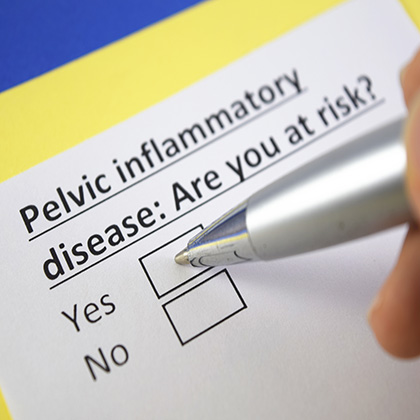Vaginitis – also sometimes called vulvovaginitis or vulvitis – is the name for inflammation of the vagina and vulval area (though strictly speaking, vaginitis refers to inflammation of the vagina while vulvovaginitis describes inflammation of the vagina and vulva). It’s not actually a disease or a condition in itself, but it’s used as a general term to describe various conditions that cause infection or inflammation of the vagina and vulva (the external sex organs that surround the vaginal opening).
As well as soreness and swelling, vaginitis can cause a number of other symptoms including itching, irritation, pain while urinating or having sex, an abnormal vaginal discharge, a strong smell and light bleeding or spotting.
Some of the conditions that can cause vaginitis include the following:
-
Vaginal thrush (candida of the genitals)
This is a yeast infection that’s thought to affect up to three quarters of all women at some point in their lives (i). -
Bacterial vaginosis
A bacterial infection of the vagina, bacterial vaginosis (BV) is caused by an upset in the natural balance of vaginal bacteria, and is often a mild problem that lasts a few days or so. -
Sexually transmitted infections
STIs such as chlamydia, genital herpes, gonorrhoea and trichomoniasis are also causes of vaginitis. Apart from genital herpes, they can be treated with antibiotics (genital herpes cannot be cured but the symptoms are usually managed using antiviral drugs).
Things that irritate the vagina and vulval area can also cause vaginitis. These include chemicals found in a number of products such as bubble baths, scented lotions, perfumed soaps, creams, hygiene sprays, scented toilet paper, wipes, deodorised sanitary pads and tampons, lubricated condoms, spermicides, scented washing powders and douches (products used to wash out the vagina, many of which contain antiseptics and fragrances).
Wearing tight-fitting trousers and underwear made from synthetic fabrics may also irritate the vagina and vulval area, causing vaginitis. Some experts believe vaginitis may also be caused by activities such as horse riding, cycling, swimming and using a hot tub.
When to see your GP
Because it’s not always simple to figure out what’s causing vaginitis, it’s important to see your GP about vaginal and vulval inflammation, especially if this is the first time you’ve had vaginitis or you’ve had it in the past but the symptoms are different this time.
It’s also essential to get advice from a health professional if you think you may have a STI, particularly if you’ve had a number of sexual partners or a new sexual partner recently. If you have an STI without knowing about it, not only could you spread it to other people but if you don’t treat it, it could become more serious (chlamydia, for example, can lead to long-term health problems if left untreated).
If you don’t want to see your GP about a potential STI, you can go to your local sexual health or genitourinary medicine (GUM) clinic. Click here to find a clinic in your area.
Vaginal thrush and bacterial vaginosis
Two of the most common causes of vaginitis are candida – or, more specifically, candida of the genitals, which is more usually called vaginal thrush and bacterial vaginosis.
Vaginal thrush
The NHS claims vaginal thrush is a common yeast infection is caused by a group of fungi called candida, which is often present in the vagina without causing any problems (ii).
If, however, the candida yeasts multiply and upset the natural balance of bacteria and other micro-organisms in the vagina, it can cause an infection. This infection causes vaginitis symptoms including itching and soreness around the entrance of the vagina, a vaginal discharge, pain during sex and pain during urination.
If you’ve had thrush before and treated it with over-the-counter medicines, you should normally be able to do the same again. There are several types of vaginal thrush medicines you can buy, including pessaries, vaginal creams and capsules. If, however, it’s the first time you’ve had thrush, it’s a good idea to see your GP or go to your local sexual health clinic. Also see a health professional if your symptoms don’t improve after using over-the-counter thrush medicines for one or two weeks.
There are several ways of protecting yourself against vaginal thrush. Avoiding chemical irritants can help – such as those found in perfumed bath and body products (including vaginal deodorants, wipes and douches) – as can avoiding wearing tight underwear. If you have diabetes, keeping your blood glucose levels under control may also help prevent recurrent episodes of vaginal thrush.
Click here for more information about candida and thrush.
Bacterial vaginosis
Thought to be one of the most common causes of vaginal discharge, bacterial vaginosis (BV) sometimes – but not always – causes other common vaginitis symptoms such as soreness and itching (some women can have BV without any symptoms). Like vaginal thrush, BV can develop when the natural balance of micro-organisms in the vagina is affected – in this case, when the number of certain bacteria increases.
Factors that can raise your risk of developing BV include being sexually active (though the condition isn’t officially classed as a sexually transmitted infection), using strong detergents to wash your clothes, and using scented or antiseptic bath and body products and vaginal deodorants. The NHS claims having a method of contraception fitted called an inter-uterine device (IUD) may also make you more susceptible to BV (iii), while some other experts have also linked an increased risk of the condition to smoking (iv).
If you notice an unusual vaginal discharge, it may be the only symptom of BV that affects you. Not getting it treated, however, can lead to complications, especially if you are or become pregnant (premature birth and miscarriage are just two of the pregnancy-related complications linked with BV). Other complications include a greater risk of catching a sexually transmitted infection such as chlamydia and a possible increased risk of developing pelvic inflammatory disease.
The good news is BV is easily treated with a short course of antibiotics. However the NHS claims some women need more than one course of antibiotics to treat their BV effectively (v).
What is atrophic vaginitis?
After the menopause, many women are affected by a type of vaginitis called atrophic vaginitis. Symptoms include vaginal dryness, itching and discomfort – particularly during sex – which are largely the result of the lining of the vagina becoming thinner.
Before the menopause, a woman’s ovaries produce a certain level of the hormone oestrogen. This hormone affects the tissues in and around the vagina, keeping it thicker and lubricated. But after the menopause, less oestrogen is produced, and one of the results is a thinning of the tissues of the vagina.
Experts believe up to 63 per cent of women have experienced vulvovaginal symptoms, most commonly that of vaginal dryness after the menopause (vi) – though it’s thought more may be affected but are too embarrassed to talk to their GPs about it.
Apart from vaginal soreness, itching and discomfort, women with atrophic vaginitis may also experience a vaginal discharge – which may or may not be caused by an infection – and urinary problems, such as recurring urinary infections and frequent urges to urinate.
How is it treated?
There are a couple of things you can do yourself if you have the symptoms of atrophic vaginitis. Avoid using perfumed soaps and other bath and body products, as these can make the dryness worse (instead, wash your intimate area with plain water or water and a mild soap-free cleanser). You can also try using a genital lubricant or vaginal moisturiser when you have sex – several are available over the counter.
Meanwhile hormone replacement therapy (HRT) is often used to relieve the symptoms of atrophic vaginitis. HRT is available in tablets, gels or patches, and works by boosting your body’s level of oestrogen (and, in some forms of HRT, other hormones). It may be useful if you’re experiencing other menopause symptoms, but is usually only recommended for short-term use as taking HRT in the long term has been linked with several potentially serious side effects.
Your GP can also prescribe topical hormone treatments such as creams, vaginal tablets and vaginal rings. These boost the oestrogen level in your vagina without it having to affect the rest of your body. However, the creams can damage latex condoms and diaphragms, so you may have to use other types of contraception or use the vaginal tablets or ring (vii).
Some women also find hormone replacement therapy (HRT) helps relieve the symptoms of atrophic vaginitis. HRT is available in tablets, gels or patches, and works by boosting your body’s level of oestrogen (and, in some forms of HRT, other hormones). It may be useful if you’re experiencing other menopause symptoms, but is usually only recommended for short-term use as taking HRT in the long term has been linked with several potentially serious side effects.
Vagina self-care tips
The vagina is home to various micro-organisms, including yeasts and bacteria. In fact, experts claim that, apart from the bowel, the vagina contains more bacteria than any other part of the body.
Many of these bacteria are beneficial as they help maintain the vagina’s acid-alkaline (or pH) balance. If the vagina’s acid-alkaline balance becomes too acidic, the result can be an infection such as thrush or bacterial vaginosis. Meanwhile, the vagina’s beneficial bacteria also produce substances that reduce or kill other, more harmful, bacteria by one means or another.
When it comes to looking after your vagina and vulval area, most experts agree it’s not a good idea to use perfumed products to clean them, as the chemicals in such products can disrupt the balance of good to bad bacteria in the vagina.
According to the NHS, the best way to keep yourself clean is to use plain, non-perfumed soaps to wash the area around your vagina (the vulva) every day as part of your usual shower or bath routine (also take warm rather than hot baths or showers).
To douche or not to douche?
Douching – that is, using a product or water to flush out the vagina – is more popular in the US than it is here in the UK. It’s thought to help keep you feel clean and fresh. But experts believe douching can disrupt the balance of bacteria in the vagina, making you more susceptible to vaginitis. And there is no evidence douching protects against sexually transmitted infections (STIs) or vaginal infections, says the NHS – in fact, it may even increase the risk (ix).
Scented wipes and vaginal deodorants have the same effect as douching, say experts (ix). If, however, you’re tempted to use one of these products to tackle vaginal odour, there’s a chance you may have an infection such as bacterial vaginosis – so see your GP, who can prescribe the right treatment to get rid of the cause of the odour.
Other things that can help keep your vagina happy include wearing loose-fitting cotton underwear during the day, and going without underwear while you sleep.
If you’re sexually active, it’s worth bearing in mind that using condoms protects against the bacteria and viruses that cause STIs (which in turn cause vaginitis), such as chlamydia, gonorrhoea and genital herpes.
Natural remedies for vaginitis
Two of the most common causes of vaginitis – namely thrush and bacterial vaginosis (BV) – are thought to be caused by an imbalance of bacteria and other micro-organisms in the vagina, such as L acidophilus and B bifidus. This explains why many natural health practitioners believe supplements that may help maintain that balance may be useful, either for preventing the symptoms of vaginitis or for treating them.
Indeed, there is some evidence that taking live bacteria supplements may reduce the risk of developing thrush, thanks to the way they’re thought to help maintain a healthy bacterial balance in the vagina (x). Another small-scale study suggests acidophilus may help prevent the recurrence of vaginitis when implanted in the vagina as non-fermented acidophilus milk or yoghurt (xi).
Supplements containing indigestible starches called fructo-oligosaccharides (FOS) could also be useful to maintain a good bacterial balance in the vagina, as these starches are thought to ‘feed’ bacteria in the gut – most notably the beneficial (or ‘friendly’) bacteria.
Meanwhile, vitamin D may not normally be associated with vaginitis symptoms, but there is a study that supports the idea it might help treat BV effectively. The researchers initially noted that vitamin D deficiency is often found in women of reproductive age, among whom BV is a common vaginal infection.
The scientists treated around half of a group of 208 women who had asymptomatic BV (that is, they had no symptoms) with vitamin D drops. Then after 105 days they found more of those taking the drops were cured compared to those in the control group who didn’t take any drops (63 per cent of the vitamin D group were cured compared with 19 per cent of the control group) (xii). The conclusion? Vitamin D may be an effective treatment for women of reproductive age with BV who also have a vitamin D deficiency.
The recommended form of vitamin D is vitamin D3 or cholecalciferol, as it’s the natural form of vitamin D that the body makes when it’s exposed to sunlight. Vitamin D3 supplements are available in tablet form, and now you can get them in veggie-friendly drops too.
However, most vitamin D3 supplements are made from the fat of lamb’s wool, which means they’re unsuitable for vegans. The good news is that vegan vitamin D3 supplements sourced from lichen are now more widely available.
Vaginitis can be an uncomfortable condition, and if you think you have symptoms, it’s best to see a doctor or qualified sexual health practitioner who will be able to give you advice on treatment of the underlying cause. For more advice on the causes and treatments of common health conditions, visit our dedicated resources in the health library.
References:
-
Available online: https://patient.info/sexual-health/vaginal-discharge-female-discharge/vaginal-thrush-yeast-infection
-
Available online: https://www.nhsinform.scot/illnesses-and-conditions/infections-and-poisoning/vaginal-thrush
-
Available online: https://www.nhs.uk/conditions/bacterial-vaginosis/
-
Nelson TM. et al., Cigarette smoking is associated with an altered vaginal tract metabolomic profile. Scientific Reports. 2018;8(852).Available online: https://www.nature.com/articles/s41598-017-14943-3
-
Available online: https://www.nhsinform.scot/illnesses-and-conditions/sexual-and-reproductive/bacterial-vaginosis#treating-bacterial-vaginosis
-
Available online: https://patient.info/doctor/atrophic-vaginitis
-
Available online: https://patient.info/doctor/hrt-topical
-
Available online: https://www.nhs.uk/conditions/vaginitis/
-
Available online: https://www.nhs.uk/live-well/sexual-health/keeping-your-vagina-clean-and-healthy/
-
Reid. G, Charbonneau. D, Erb. J, et al. Oral use of Lactobacillus rhamnosus GR-1 and L. fermentum RC-14 significantly alters vaginal flora: randomized, placebo-controlled trial in 64 healthy women. FEMS Immunol Med Microbiol. 2003;35:131-134. Available online: https://pubmed.ncbi.nlm.nih.gov/12628548-oral-use-of-lactobacillus-rhamnosus-gr-1-and-l-fermentum-rc-14-significantly-alters-vaginal-flora-randomized-placebo-controlled-trial-in-64-healthy-women/
-
Collins. EB, Hardt. P. Inhibition of Candida albicans by Lactobacillus acidophilus. J Dairy Sci. 1980;63:830-2. Available online: https://pubmed.ncbi.nlm.nih.gov/6771309-inhibition-of-candida-albicans-by-lactobacillus-acidophilus/
-
Taheri. M, Baheiraei. A, Foroushani. AR, et al. Treatment of vitamin D deficiency is an effective method in the elimination of asymptomatic bacterial vaginosis: A placebo-controlled randomized clinical trial. Indian J Med Res. 2015;141:799–806. Available online: https://pubmed.ncbi.nlm.nih.gov/26205023-treatment-of-vitamin-d-deficiency-is-an-effective-method-in-the-elimination-of-asymptomatic-bacterial-vaginosis-a-placebo-controlled-randomized-clinical-trial/
Related Posts
Disclaimer: The information presented by Nature's Best is for informational purposes only. It is based on scientific studies (human, animal, or in vitro), clinical experience, or traditional usage as cited in each article. The results reported may not necessarily occur in all individuals. Self-treatment is not recommended for life-threatening conditions that require medical treatment under a doctor's care. For many of the conditions discussed, treatment with prescription or over the counter medication is also available. Consult your doctor, practitioner, and/or pharmacist for any health problem and before using any supplements or before making any changes in prescribed medications.

Christine
Christine Morgan has been a freelance health and wellbeing journalist for almost 20 years, having written for numerous publications including the Daily Mirror, S Magazine, Top Sante, Healthy, Woman & Home, Zest, Allergy, Healthy Times and Pregnancy & Birth; she has also edited several titles such as Women’ Health, Shine’s Real Health & Beauty and All About Health.
View More



